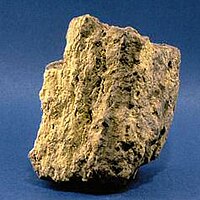
Photo from wikipedia
Abstract The GT-34 deposit, located 12 km to the SW of the Sossego copper-gold mine in the Carajas Province, northern Brazil, represents an unusual Ni sulfide mineralization. The deposit occurs… Click to show full abstract
Abstract The GT-34 deposit, located 12 km to the SW of the Sossego copper-gold mine in the Carajas Province, northern Brazil, represents an unusual Ni sulfide mineralization. The deposit occurs along a NE-SW-trending sub-vertical shear zone marked by progressive Mg-alkalic alteration zones, predominantly hosted in granitic and locally in granodioritic to tonalitic orthogneisses. Initial alteration zones result in unique scapolite-orthopyroxene assemblage, which is partially preserved within pervasive hornblende-chlorapatite ± plagioclase replacement zones. Nickel mineralization occurs mainly as matrix-supported breccias characterized by a pentlandite-pyrrhotite-rich matrix and rounded fragments chiefly of hornblende and chlorapatite. Irregular stockworks and net textured veins containing chalcopyrite-pentlandite are less common. Phlogopite ± talc ± actinolite alteration and late-stage veinlets crosscut the previous alteration zones and the mineralization. The phlogopite ± talc ± actinolite alteration occurs as irregular veins and chalcopyrite-pyrrhotite-magnetite are commonly observed where such alteration intersects the Ni mineralization. Late-stage veinlets are represented by K feldspar-epidote-chlorite-calcite and quartz-albite-chlorite-calcite-epidote veins, both containing minor amounts of millerite, pyrite and F-OH-apatite. High-resolution SIMS U-Pb zircon geochronology obtained for the GT-34 deposit revealed an age of 2828 ± 4 Ma for zircon grains inherited from the host orthogneisses. The timing of the mineralization altered zircon grains from the scapolite-orthopyroxene and phlogopite ± talc ± actinolite alteration zones, is attributed to an age interval between 2751 and 2720 Ma. Although poorly constrained, the geochronological data corroborate a Neoarchean age for the GT-34 Ni mineralization, similar to that of other IOCG deposits in the Carajas Province and coeval with the bimodal magmatism in the area. The atypical orthopyroxene-marialite mineral chemistry support a metasomatic crystallization at high temperatures (>700°C), low aH2O (
Journal Title: Ore Geology Reviews
Year Published: 2020
Link to full text (if available)
Share on Social Media: Sign Up to like & get
recommendations!